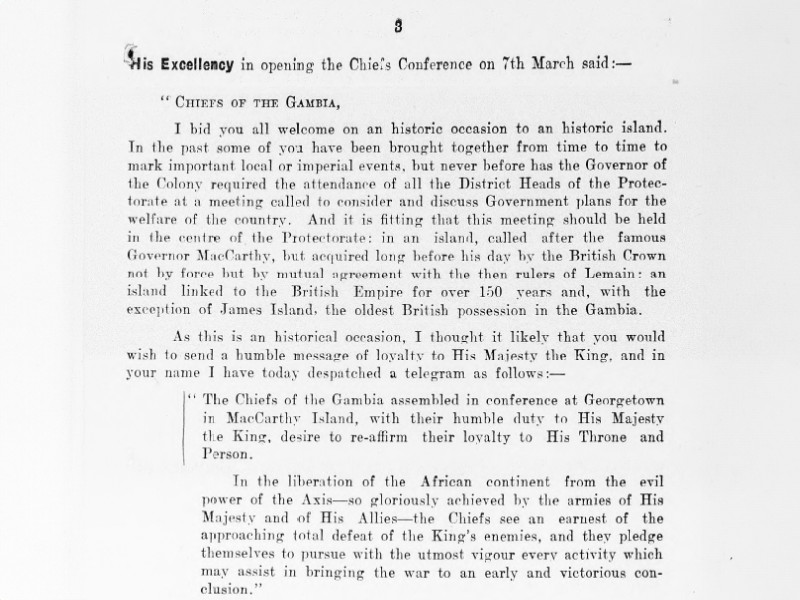Gambia Under Colonial Rule, in Government Reports, 1881–1966

Annual Departmental Reports relating to the Gambia, 1881–1966
In the past some of you have been brought together from time to time to mark important local or imperial events, but never before has the Governor of the Colony required the attendance of all the District Heads of the Protectorate at a meeting called to consider and discuss Government plans for the welfare of the country.img 6
Access the full collection
Access the full archive of Gambia Under Colonial Rule, in Government Reports, 1881–1966.
Institutional Free Trial
Start your free trialRegister for a free 30-day trial of Gambia Under Colonial Rule, in Government Reports, 1881–1966, for your institution.
Institutional Sales
Visit Sales PagesellFor more information on institutional access, visit our sales page.
Single User License
Purchase a license below to view the full collection.
Already have a license? Sign in.
Explore key government reports that chart Gambia’s journey towards independence

This comprehensive collection explores in detail Gambia’s history under British colonial rule through extensive governmental reports. Beginning near the end of the nineteenth century with the formation of Gambia as a British colony and protectorate, this collection tracks the wide-ranging administrative duties of various governmental departments within Gambia up until the country’s independence in the 1960s.
From recording crime and disease levels throughout the territory, to in-depth reports concerning agricultural reform. These documents contributed by The British and Commonwealth Office provide a thorough level of insight into Gambia’s history as a British colony.
This collection is accompanied by an online guide to the microfilm edition by D. C. Dorward, Lecturer in African History, La Trobe University, Melbourne, Australia.
Contents
Gambia Under Colonial Rule, in Government Reports, 1881–1966...
Annual Departmental Reports relating to the Gambia, 1881–1966
Discover
Highlights

Licensed to access Agriculture, 1923-1952
Agricultural reports largely document the expansion of Gambia’s groundnut (peanut) industry which remains the country’s largest export to this day. Includes reports concerning agricultural strategies designed to increase crop yields and detailed records of local weather patterns.

Licensed to access Medical Dept Reports, 1909-1921
Explore reports and statistics recording the levels of incidence of diseases present in the local population. Additionally included are reports detailing various strategies for disease prevention and extensions of the Victoria Hospital in Bathurst (Banjul).
Insights
The British Empire established the military post of Bathurst on the island of Banjul in 1816. This territory — previously under the jurisdiction of the British Governor-General in Sierra Leone — became a separate colony in 1888, with its borders officially drawn in 1889 following an agreement with the French republic.
As seen in the Public Services and Natural Resources volumes, the Government encountered many challenges while attempting to install an adequate infrastructure that would result in profit and successful colonial rule. Detailed within the collection, Gambia’s climate was of particular concern for the colony’s agricultural efforts.
The local groundnut (peanut) industry was quickly seized upon as a source of income for the British Empire. The collection details how Western agricultural practices were introduced to the Gambia, resulting in the groundnut becoming one of the country’s largest exports. Explore the Trade and Shipping volume for further insight into Gambia’s exports and imports and how they were affected during the two World Wars.
Receiving its own executive and legislative councils in 1901, Gambia slowly started to shift towards being a self-governing colony. Outlined within the collection are records concerning Gambia’s judicial system and details of local crime incidences as well as reports on local prisons throughout the colony.
Following the Second World War, calls for constitutional reform became increasingly loud throughout the country. Contained within this collection are extensive records of conferences between the British Government and Gambia’s local chieftains. These allow readers to trace the gradual transfer of power from the British Empire to the Gambian people, culminating in the UK granting Gambia full internal self-governance in 1965.
Unlock Historical Research for Your Institution
Provide your students and researchers with direct access to unique primary sources.







